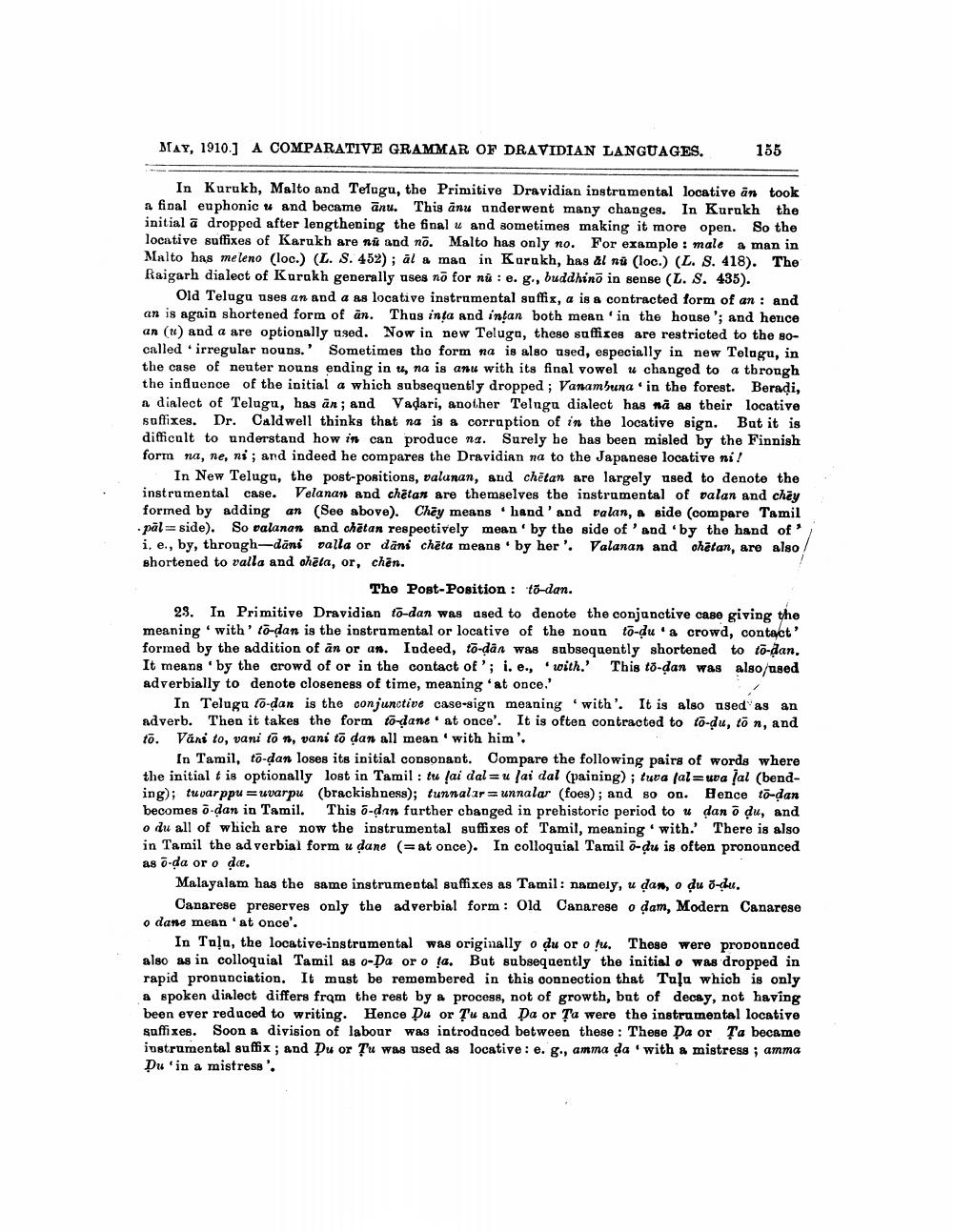________________
MAY, 1910.) A COMPARATIVE GRAMMAR OF DRAVIDIAN LANGUAGES.
155
In Kurukh, Malto and Telugu, the Primitive Dravidian instrumental locative an took a fipal euphonic w and became ānu. This anu anderwent many changes. In Kurukh the initial a dropped after lengthening the final u and sometimes making it more open. So the locative suffixes of Karukh are nû and no. Malto has only no. For example: male a man in Malto has meleno (loc.) (L. S. 452); al a man in Kurukh, has al nu (loc.) (L. S. 418). The Raigarh dialect of Kurakh generally uses no for nú : e. g., buddhino in sense (L. S. 435).
Old Telugu uses an and a as locative instrumental suffix, a is a contracted form of an : and an is again shortened form of an. Thus inta and intan both mean' in the house'; and hence un (1) and a are optionally used. Now in new Teluga, these suffices are restricted to the 80called irregular nouns.' Sometimes the form na is also used, especially in new Telugu, in the case of neuter nouns ending in th, na is anu with its final vowel u changed to a tbrongh the influence of the initial a which subsequently dropped ; Vanambuna in the forest. Beradi, a dialect of Telugu, has an; and Vadari, another Telugu dialect has nå as their locative soffixes. Dr. Caldwell thinks that na is & corruption of in the locative sign. But it is difficult to understand how in can produce na. Surely he has been misled by the Finnish form na, ne, ni; and indeed he compares the Dravidian na to the Japanese locative ni!
In New Telugu, the post-positions, valunan, and chētan are largely used to denote the instrumental case. Velanan and chetan are themselves the instrumental of valan and chey formed by adding an (See above). Chey means hand' and valan, a side (compare Tamil pål= side). So valanan and chetan respeetively mean' by the side of 'and by the hand of' i, e., by, through-däni valla or dāni cheta means by her'. Valanan and chetan, are also shortened to valla and shēla, or, chên.
The Post-Position : to-dan. 23. In Primitive Dravidian to-dan was ased to denote the conjunctive case giving the meaning with' fo-dan is the instrumental or locative of the noun to-du'a crowd, contact' formed by the addition of an or an. Indeed, to-dan was subsequently shortened to to-dan. It means by the crowd of or in the contact of'; i. e., with.' This tö-dan was also/used adverbially to denote closeness of time, meaning at once.'
In Telugu fo dan is the conjunctive case-sign meaning with'. It is also used as an adverb. Then it takes the form to dane' at once'. It is often contracted to fo-du, to n, and tö. Väni to, vani to, vani to dan all mean' with him'.
In Tamil, to-dan loses its initial consonant. Compare the following pairs of words where the initial t is optionally lost in Tamil : tu fai dal=ulai dal (paining); tura fal=uva lal (bending); tuvarppu = uvarpu (brackishness); tunnalar=unnalar (foes); and so on. Hence to-dan becomes 7.dan in Tamil. This 6-dan further changed in prehistoric period to u dan 7 du, and o du all of which are now the instrumental suffixes of Tamil, meaning with. There is also in Tamil the ad verbial form u dane (=at once). In colloquial Tamil -du is often pronounced as -da or o dce.
Malayalam has the same instrumental suffixes as Tamil: namely, u dan, o du du.
Canarese preserves only the adverbial form: Old Canarese o dam, Modern Canarese o dane mean'at once'.
In Tola, the locative-instrumental was originally o du oro tu. These were propounced also as in colloquial Tamil as o-Da oro ta. But subsequently the initial o was dropped in rapid pronunciation. It must be remembered in this connection that Tuļu which is only a spoken dialect differs from the rest by a process, not of growth, but of decay, not having been ever reduced to writing. Hence Du or Țu and Da or Ța were the instrumental locative gaffixes. Soon a division of labour was introduced between these : These pa or Ta became instrumental suffix ; and Du or Țu was used as locative : e. g., amma da with a mistress ; amma Du'in a mistress




